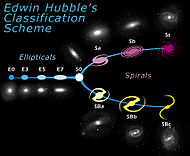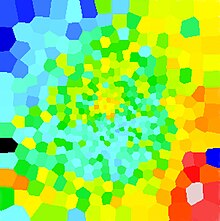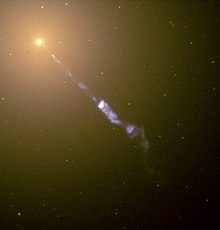From Wikipedia, the free encyclopedia
Messier 87 (also known as
Virgo A or
NGC 4486, generally abbreviated to
M87) is a
supergiant elliptical galaxy in the constellation
Virgo. One of the most massive galaxies in the local Universe, it is notable for its large population of
globular clusters—about 12,000 compared to the 150–200 orbiting the
Milky Way—and its jet of energetic
plasma that originates at the core and extends at least 1,500
parsecs (4,900
light-years), traveling at
relativistic speed. It is one of the brightest radio sources in the sky, and a popular target for both amateur and professional astronomers.
The French astronomer
Charles Messier discovered M87 in 1781, and catalogued it as a
nebulous
feature while searching for objects that would otherwise confuse comet
hunters. M87 is located about 16.4 million parsecs (53 million
light-years) from Earth and is the second-brightest galaxy within the
northern
Virgo Cluster, having many
satellite galaxies. Unlike a disk-shaped
spiral galaxy, M87 has no distinctive
dust lanes. Instead, it has an almost featureless,
ellipsoidal shape typical of most giant elliptical galaxies, diminishing in
luminosity with distance from the center. Forming around one sixth of its mass, M87's
stars
have a nearly spherically symmetric distribution. Their population
density decreases with increasing distance from the core. It has an
active
supermassive black hole at its core, which forms the primary component of an
active galactic nucleus.
The galaxy is a strong source of multiwavelength radiation, particularly
radio waves.
Its galactic envelope extends to a radius of about 150 kiloparsecs
(490 thousand light-years), where it is truncated—possibly by an
encounter with another galaxy. Its
interstellar medium consists of diffuse gas enriched by elements emitted from
evolved stars.
Observation history
In 1781, the French astronomer Charles Messier published a
catalogue
of 103 objects that had a nebulous appearance as part of a list
intended to identify objects that might otherwise be confused with
comets.
In subsequent use, each catalogue entry was prefixed with an "M". Thus,
M87 was the eighty-seventh object listed in Messier's catalogue. During the 1880s, the object was included as NGC 4486, in the
New General Catalogue of nebulae and star clusters assembled by the Danish-Irish astronomer
John Dreyer, which he based primarily on the observations of the English astronomer
John Herschel.
In 1918, the American astronomer
Heber Curtis of
Lick Observatory
noted M87's lack of a spiral structure and observed a "curious straight
ray ... apparently connected with the nucleus by a thin line of
matter." The ray appeared brightest near the galactic center. The following year, a
supernova within M87 reached a peak
photographic magnitude of 21.5, although this event was not reported until photographic plates were examined by the Russian astronomer
Innokentii A. Balanowski in 1922.
Identification as galaxy
In 1922, the American astronomer
Edwin Hubble
categorized M87 as one of the brighter globular nebulae, as it lacked
any spiral structure, but like spiral nebulae, appeared to belong to the
family of non-galactic nebulae.
In 1926 he produced a new categorization, distinguishing extragalactic
from galactic nebulae, the former being independent star systems. M87
was
classified as a type of elliptical extragalactic nebula with no apparent elongation (class E0).
In 1931, Hubble described M87 as a member of the
Virgo Cluster,
and gave a provisional estimate of 1.8 million parsecs (5.9 million
light-years) from Earth. It was then the only known elliptical nebula
for which individual stars could be
resolved, although it was pointed out that globular clusters would be indistinguishable from individual stars at such distances. In his 1936
The Realm of the Nebulae, Hubble examines the terminology of the day; some astronomers labeled extragalactic nebulae as
external galaxies on the basis that they were stellar systems at far distances from our own galaxy, while others preferred the conventional term
extragalactic nebulae, as
galaxy then was synonym for the Milky Way. M87 continued to be labelled as an extragalactic nebula at least until 1954.
Modern research
In 1947, a prominent
radio source, Virgo A, was identified overlapping the location of M87. The source was confirmed to be M87 by 1953, and the linear
relativistic jet emerging from the core of the galaxy was suggested as the cause. This jet extended from the core at a
position angle of 260° to an
angular distance of 20
″ with an angular width of 2″. In 1969–70, a strong component of the radio emission was found to closely align with the optical source of the jet.
In 1966, the
United States Naval Research Laboratory's
Aerobee 150 rocket identified Virgo X-1, the first X-ray source in Virgo. The Aerobee rocket launched from
White Sands Missile Range on 7 July 1967, yielded further evidence that the source of Virgo X-1 was the radio galaxy M87. Subsequent X-ray observations by the
HEAO 1 and
Einstein Observatory showed a complex source that included the active galactic nucleus of M87. However, there is little central concentration of the X-ray emission.
M87 has been an important testing ground for techniques that
measure the masses of central supermassive black holes in galaxies. In
1978,
stellar-dynamical modeling of the mass distribution in M87 gave evidence for a central mass of five billion
solar masses. After the installation of the
COSTAR corrective-optics module in the
Hubble Space Telescope in 1993, the Hubble
Faint Object Spectrograph (FOS) was used to measure the
rotation velocity
of the ionized gas disk at the center of M87, as an "early release
observation" designed to test the scientific performance of the
post-repair Hubble instruments. The FOS data indicated a central black
hole mass of 2.4 billion solar masses, with 30% uncertainty.
Visibility
Area in constellation Virgo around M87
M87 is located near the high
declination border of the Virgo constellation, next to the constellation of
Coma Berenices. It lies along the line between the stars
Epsilon Virginis and
Denebola. At an
apparent magnitude of 9.59, the galaxy can be observed using a small telescope with a 6 cm (2.4 in)
aperture, extending across an angular area of 7.2 × 6.8
arcminutes with a bright, 45-
arcsecond core. Viewing the jet is a challenge without the aid of photography. Before 1991, the Russian-American astronomer
Otto Struve was the only person known to have seen the jet visually, using the 254 cm (100 in)
Hooker telescope. In more recent years it has been observed in larger amateur telescopes under excellent conditions.
Properties
Huge halo around Messier 87
In the modified
Hubble sequence galaxy morphological classification scheme of the French astronomer
Gérard de Vaucouleurs,
M87 is categorized as an E0p galaxy. "E0" designates an elliptical
galaxy that displays no flattening—that is, it appears spherical. A "p" suffix indicates a
peculiar galaxy
that does not fit cleanly into the classification scheme; in this case,
the peculiarity is the presence of the jet emerging from the core. In the
Yerkes (Morgan) scheme, M87 is classified as a
type-cD galaxy.
A D galaxy has an elliptical-like nucleus surrounded by an extensive,
dustless, diffuse envelope. A D type supergiant is called a cD galaxy.
M87 is one of the most massive galaxies in the local Universe.
It spans a diameter of 120 thousand light-years, which is slightly
lower than that of the Milky Way, but M87 is a spheroid, not a flat
spiral. The mass of M87 within a radius (
r) of 9–40 kiloparsecs (29–130 thousand light-years) from the core steadily increases roughly
in proportion to
r1.7. Within a radius of 32 kiloparsecs (100 thousand light-years), the mass is
(2.4 ± 0.6) × 1012 times the
mass of the Sun, which is double the mass of the
Milky Way galaxy. Only a fraction of this mass is in the form of stars. M87 has an estimated mass to luminosity ratio of
6.3 ± 0.8; that is, about one part in six of the galaxy's mass is in the form of stars that radiate energy. The total mass of M87 may be 200 times that of the Milky Way.
Stellar
velocity map of the central region of M87, showing the motion of stars
relative to Earth. Blue patches represent motion towards the Earth and
red ones away from the Earth, while yellow and green are in between the
two extremes. The map signifies random motion of the stars.
Gas is infalling into the galaxy at the rate of two to three solar
masses per year, most of which may be accreted onto the core region. The extended stellar envelope of this galaxy reaches a radius of about 150 kiloparsecs (490 thousand light-years), compared to about 100 kiloparsecs (330 thousand light-years) for the Milky Way.
Beyond that distance the outer edge of the galaxy has been truncated by
some means; possibly by an earlier encounter with another galaxy. There is evidence of linear streams of stars to the northwest of the galaxy, which may have been created by
tidal stripping of orbiting galaxies or by small
satellite galaxies falling in toward M87.
Moreover, a filament of hot, ionized gas in the northeastern outer part
of the galaxy may be the remnant of a small, gas-rich galaxy that was
disrupted by M87 and could be feeding its active nucleus. M87 is estimated to have at least 50 satellite galaxies, including
NGC 4486B and
NGC 4478.
The spectrum of the nuclear region of M87 shows the
emission lines
of various ions, including hydrogen (HI, HII), helium (HeI), oxygen
(OI, OII, OIII), nitrogen (NI), magnesium (MgII) and sulfur (SII). The
line intensities for weakly ionized atoms (such as neutral
atomic oxygen, OI) are stronger than those of strongly ionized atoms (such as
doubly ionized oxygen, OIII). A galactic nucleus with such spectral properties is termed a LINER, for "
low-ionization nuclear emission-line region".
The mechanism and source of weak-line-dominated ionization in LINERs
and M87 are under debate. Possible causes include shock-induced
excitation in the outer parts of the disk or
photoionization in the inner region powered by the jet.
Elliptical galaxies such as M87 are believed to form as the result of one or more mergers of smaller galaxies. They generally contain relatively little cold
interstellar gas
(in comparison with spiral galaxies) and they are populated mostly by
old stars, with little or no ongoing star formation. M87's elliptical
shape is maintained by the random orbital motions of its constituent
stars, in contrast to the more orderly rotational motions found in a
spiral galaxy such as the Milky Way. Using the
Very Large Telescope
to study the motions of about 300 planetary nebulae, astronomers have
determined that M87 absorbed a medium-sized star-forming spiral galaxy
over the last billion years. This has resulted in the addition of some
younger, bluer stars to M87. The distinctive spectral properties of the
planetary nebulae allowed astronomers to discover a chevron-like
structure in M87's halo which was produced by the incomplete
phase-space mixing of a disrupted galaxy.
Components
Supermassive black hole
The core contains a supermassive black hole that weighs billions of times the Sun's mass:
estimates have ranged from
(3.5 ± 0.8) × 109 M☉
to
(6.6 ± 0.4) × 109 M☉,
with the latest measurement being
7.22+0.34
−0.40×109 M☉.
This mass is one of the
highest known
for such an object. A rotating disk of ionized gas surrounds the black
hole, and is roughly perpendicular to the relativistic jet. The disk
rotates at velocities of up to roughly 1,000 km/s, and spans a maximum diameter of 0.12 parsecs (0.39 light-years). Gas
accretes onto the black hole at an estimated rate of one solar mass every ten years (about 90
earth masses per day).
Observation suggests that the black hole may be displaced from the galactic center by about seven parsecs (23 light-years).
The displacement is in the opposite direction of the one-sided jet,
which may indicate that the black hole was accelerated away by the jet.
Another possibility is that the change in location occurred during the
merger of two supermassive black holes. A 2011 study did not find any statistically significant displacement.
Interstellar medium
The
space between the stars in M87 is filled with a diffuse interstellar
medium of gas that has been chemically enriched by the elements ejected
from stars as they passed beyond their
main sequence lifetime. Carbon and nitrogen are continuously supplied by stars of intermediate mass as they pass through the
asymptotic giant branch. The heavier elements from oxygen to iron are produced largely by
supernova
explosions within the galaxy. Of the heavy elements, about 60% were
produced by core-collapse supernovae, while the remainder came from
type Ia supernovae. The distribution of oxygen is roughly uniform throughout, at about half of the
solar value (i.e., oxygen abundance in the Sun), while iron distribution peaks near the center where it approaches the solar iron value.
Since oxygen is produced mainly by core-collapse supernovae, which
occur during the early stages of galaxies and mostly in outer
star-forming regions,
the distribution of these elements suggests an early enrichment of the
interstellar medium from core-collapse supernovae and a continuous
contribution from Type Ia supernovae throughout the history of M87. The contribution of elements from these sources was much lower than in the Milky Way.
Examination of M87 at far
infrared wavelengths shows an excess emission at wavelengths longer than 25 μm. Normally, this may be an indication of
thermal emission by warm dust. In the case of M87, the emission can be fully explained by
synchrotron radiation
from the jet; within the galaxy, silicate grains are expected to
survive for no more than 46 million years because of the X-ray emission
from the core. This dust may be destroyed by the hostile environment or expelled from the galaxy. The combined mass of dust in M87 is no more than 70,000 times the mass of the Sun. By comparison, the Milky Way's dust equals about a hundred million (10
8) solar masses.
Although M87 is an elliptical galaxy and therefore lacks the dust lanes of a
spiral galaxy,
optical filaments have been observed in it, which arise from gas
falling towards the core. Emission probably comes from shock-induced
excitation as the falling gas streams encounter X-rays from the core
region. These filaments have an estimated mass of about 10,000 solar masses. Surrounding the galaxy is an extended corona with hot, low-density gas.
Globular clusters
M87 has an abnormally large population of
globular clusters. A 2006 survey out to an
angular distance of 25
′ from the core estimates that there are
12,000 ± 800 globular clusters in orbit around M87,
compared to 150–200 in and around the Milky Way. The clusters are
similar in size distribution to those of the Milky Way, most having an
effective radius of 1 to 6 parsecs. The size of the M87 clusters
gradually increases with distance from the galactic center. Within a four-kiloparsec (13,000-light-year) radius of the core, the cluster
metallicity—the
abundance of elements other than hydrogen and helium—is about half the
abundance in the Sun. Outside this radius, metallicity steadily declines
as the cluster distance from the core increases. Clusters with low metallicity are somewhat larger than metal-rich clusters. In 2014,
HVGC-1,
the first hypervelocity globular cluster, was discovered escaping from
M87 at 2,300 km/s. The escape of the cluster with such a high velocity
may have been the result of a close encounter with, and subsequent
gravitational kick from, a supermassive black hole binary. If this interpretation is correct, the core of M87 would have two supermassive black holes, the result of an ancient
collision between two galaxies which merged into a single giant galaxy.
Almost a hundred ultra-compact
dwarfs
have been identified in M87. They resemble globular clusters but have a
diameter of ten parsecs (33 light-years) or more, much larger than the
three-parsec (9.8-light-year) maximum of globular clusters. It is
unclear whether they are dwarf galaxies captured by M87 or a new class
of massive globular cluster.
Jet
In this X-ray (Chandra) and radio (VLA)
composite image, hot matter (blue in X-ray) from the Virgo cluster
falls toward the core of M87 and cools, where it is met by the
relativistic jet (orange in radio), producing shock waves in the
galaxy's interstellar medium
The
relativistic jet
of matter emerging from the core extends at least 1.5 kiloparsecs
(5,000 light-years) from the nucleus and consists of matter ejected from
a supermassive black hole. The jet is highly
collimated,
appearing constrained to an angle of 60° within 0.8 parsecs (2.6
light-years) of the core, to about 16° at two parsecs (6.5 light-years),
and to 6–7° at twelve parsecs (39 light-years). Its base has the diameter of
5.5 ± 0.4 Schwarzschild radii, and is probably powered by a
prograde accretion disk around a spinning supermassive black hole. The German-American astronomer
Walter Baade found that light from the jet was
plane polarized, which suggests that the energy is generated by the acceleration of electrons moving at
relativistic velocities in a
magnetic field. The total energy of these electrons is estimated at 5.1 × 10
56 ergs (5.1 × 10
49 joules or 3.2 × 10
68 eV). This is roughly 10
13 times the energy produced by the
Milky Way in one second, which is estimated at 5 × 10
36 joules.
The jet is surrounded by a lower-velocity non-relativistic component.
There is evidence of a counter jet, but it remains unseen from the Earth
due to
relativistic beaming. The jet is
precessing, causing the outflow to form a helical pattern out to 1.6 parsecs (5.2 light-years). Lobes of expelled matter extend out to 80 kiloparsecs (260 thousand light-years).
In pictures taken by the
Hubble Space Telescope in 1999, the motion of M87's jet was measured at four to six times the speed of light. This phenomenon, called
superluminal motion,
is an illusion caused by the relativistic velocity of the jet. The time
interval between any two light pulses emitted by the jet is, as
registered by the observer, less than the actual interval due to the
relativistic speed of the jet moving in the direction of the observer.
This results in perceived
faster-than-light speeds. Detection of such motion is used to support the theory that
quasars,
BL Lacertae objects and
radio galaxies may all be the same phenomenon, known as
active galaxies, viewed from different perspectives.
It is proposed that M87 is a BL Lacertae object (with a low-luminosity
nucleus compared with the brightness of its host galaxy) seen from a
relatively large angle. Flux variations, characteristic of the BL
Lacertae objects, have been observed in M87.
Radio wavelength image of M87 showing strong radio emission from the core
Observations indicate that the rate at which material is ejected from
the supermassive black hole is variable. These variations produce
pressure waves in the hot gas surrounding M87. The
Chandra X-ray Observatory
has detected loops and rings in the gas. Their distribution suggests
that minor eruptions occur every few million years. One of the rings,
caused by a major eruption, is a shock wave 26 kiloparsecs (85 thousand
light-years) in diameter around the black hole. Other features observed
include narrow X-ray-emitting filaments up to 31 kiloparsecs
(100 thousand light-years) long, and a large cavity in the hot gas
caused by a major eruption 70 million years ago. The regular eruptions
prevent a huge reservoir of gas from cooling and forming stars, implying
that M87's evolution may have been seriously affected, preventing it
from becoming a large
spiral galaxy. These observations also indicate that the variable eruptions produce sound waves of about 56 to 59
octaves below
middle C in the medium.
M87 is a very strong source of
gamma rays,
the most energetic rays of the electromagnetic spectrum. Gamma rays
emitted by M87 have been observed since the late 1990s. In 2006, using
the
High Energy Stereoscopic System
Cherenkov telescopes, scientists measured the variations of the gamma
ray flux coming from M87, and found that the flux changes over a matter
of days. This short period indicates that the most likely source of the
gamma rays is a supermassive black hole. In general, the smaller the diameter of the emission source, the faster the variation in flux, and vice versa.
A knot of matter in the jet (designated HST-1), about 65 parsecs
(210 light-years) from the core, has been tracked by the Hubble Space
Telescope and the Chandra X-ray Observatory. By 2006, the X-ray
intensity of this knot had increased by a factor of 50 over a four-year
period, while the X-ray emission has since been decaying in a variable manner.
The interaction of relativistic jets of plasma emanating from the core with the surrounding medium gives rise to
radio lobes in active galaxies. The lobes occur in pairs and are often symmetrical.
The two radio lobes of M87 together span about 80 kiloparsecs; the
inner parts, extending up to two kiloparsecs, emit strongly at radio
wavelengths. Two flows of material emerge from this region, one aligned
with the jet itself and the other in the opposite direction. The flows
are asymmetrical and deformed, implying that they encounter a dense
intracluster medium. At greater distances, both flows diffuse into two
lobes. The lobes are surrounded by a fainter halo of radio-emitting gas.
Environment
Messier 87 is a member of the Virgo Cluster, and can be seen to lower left of this cluster image.
M87 is near the center of the
Virgo Cluster, a closely compacted structure of about 2,000 members. It forms the core of the larger
Virgo Supercluster, of which the
Local Group (including the Milky Way) is an outlying member. It is organized into at least three distinct subsystems associated with the three large galaxies—M87,
M49 and
M86—with the subgroup centered around M87 (
Virgo A) and M49 (
Virgo B). There is a preponderance of elliptical and
S0 galaxies around M87, with a chain of elliptical galaxies aligned with the jet.
In terms of mass, M87 is a dominant member of the cluster, and hence
appears to be moving very little relative to the cluster as a whole.
It is defined as the cluster center. The cluster has a sparse gaseous
atmosphere that emits X-rays that decrease in temperature toward the
middle, where M87 is located. The combined mass of the cluster is estimated to be (0.15–1.5) × 10
15 solar masses.
Measurements of the motion of intracluster
planetary nebulae
between M87 and M86 suggest that the two galaxies are moving toward
each other and that this may be their first encounter. M87 may have
interacted with
M84 in the past, as evidenced by the truncation of M87's outer halo by
tidal interactions.
The truncated halo may also have been caused by contraction due to an
unseen mass falling into M87 from the rest of the cluster, which may be
the hypothesized
dark matter.
A third possibility is that the halo's formation was truncated by early
feedback from the active galactic nucleus at the core of M87.


















